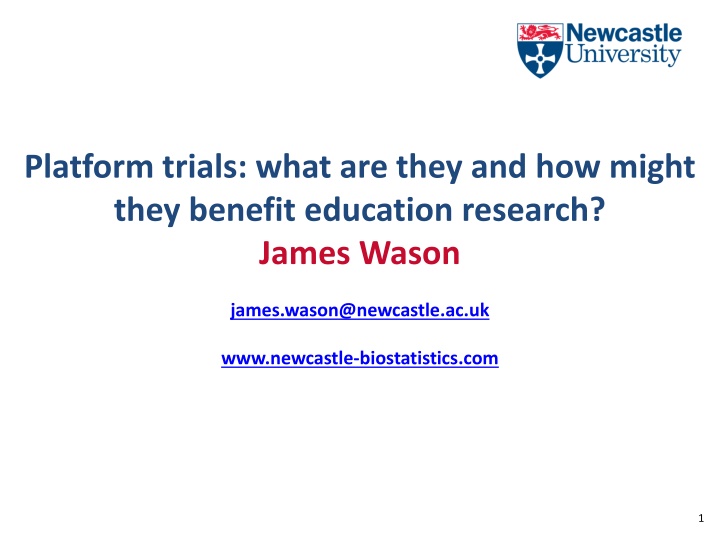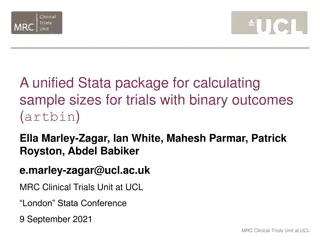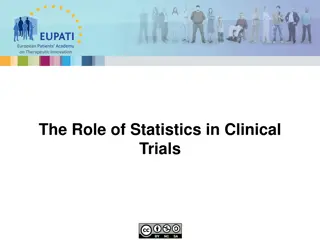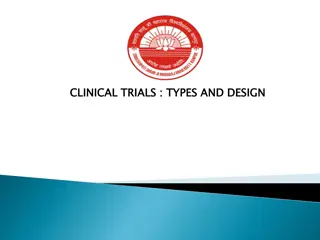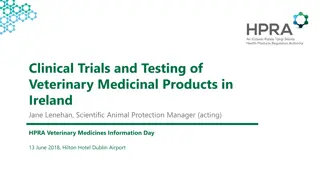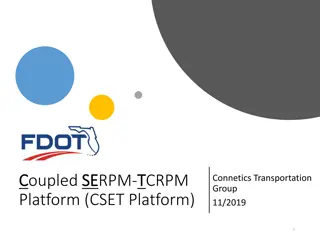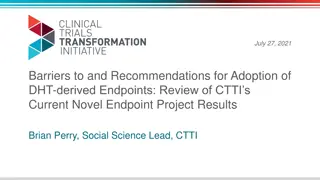Efficient Evaluation with Platform Trials
Platform trials offer a new approach in research methodology, incorporating multi-arm and adaptive designs to enhance efficiency in evaluations. By allowing flexibility in adding new treatment arms and dropping less promising ones, platform trials aim to optimize resources and reduce costs while maintaining high-quality standards in research.
Download Presentation

Please find below an Image/Link to download the presentation.
The content on the website is provided AS IS for your information and personal use only. It may not be sold, licensed, or shared on other websites without obtaining consent from the author.If you encounter any issues during the download, it is possible that the publisher has removed the file from their server.
You are allowed to download the files provided on this website for personal or commercial use, subject to the condition that they are used lawfully. All files are the property of their respective owners.
The content on the website is provided AS IS for your information and personal use only. It may not be sold, licensed, or shared on other websites without obtaining consent from the author.
E N D
Presentation Transcript
Platform trials: what are they and how might they benefit education research? James Wason james.wason@newcastle.ac.uk www.newcastle-biostatistics.com 1
Overview Increasing efficiency in evaluations Platform trials what are they? Multi-arm trials Adaptive trials Adding in new treatment arms When do they provide advantages? How might they benefit education research? 2
Evaluating new interventions Gathering high-quality information on a new intervention vital This is done through prospective trials/evaluations Gold-standard: randomised study Either individually randomised or cluster randomised 3
Innovative designs However, these are expensive! Innovative designs can help through: 1. reducing the average cost of a trial; 2. avoiding waste of resources (e.g. underpowered trials); 3. combining trials testing distinct research questions into a single master protocol or platform trial. 4
Platform trials Consists of the following elements: 1. Multiple experimental arms compared against a shared control group 2. Adaptive design allows dropping of less promising arms 3. Opportunity to add in new arms as they become available. 5
1. Multiple experimental arms When there are multiple experimental arms available for treating the same condition, multi-arm trials provide big efficiency gain: 7
1. Multiple experimental arms Advantages: Shared control group means lower sample size overall More popular with participants? Makes comparison easier compared to separate trials. Disadvantages Will be bigger/more expensive than one two-arm trial Raises the controversy of multiple testing/error rate control. If interventions are funded by industry, they might not like it. 8
2. Adaptive design An adaptive design allows the opportunity to make changes as information is collected during the study in a robust way. I.e. type I error rate and power are as specified. Why? Adaptive designs can result in shorter, more ethical trials that provide better information. 9
Example: CONFORM-OH Two-stage trial to compare three treatments for orthostatic hypotension: 1. Standard of care (SOC) (Arm A, control) 2. SOC + fludrocortisone (Arm B) 3. SOC + midodrine (Arm C) Primary outcome: Orthostatistic Hypotension Questionnaire (OHQ) at six months. Total of 366 patients to be recruited for 30 months. Initial randomisation is 1:1:1. 10
Example: CONFORM-OH Interim analysis is planned for after 200th patient is randomised. Using 3- and 6-month OHQ data, interim analysis will decide whether to continue both arms B and C, just one of them, or stop trial. Stop arm B or C if they are worse than control. If both treatments B and C are worse than control, will stop trial. Otherwise trial will continue to originally planned sample size. 11
2. Adaptive design Advantages: - Allows early stopping of ineffective interventions - More popular with participants - Reduces average sample size required by trial Disadvantages - Interim analyses must be done quickly and to high standard - Requires slightly higher maximum sample size. 12
3. Adding in new arms It s a lot of work to set up a new trial, e.g. ethical approvals, opening sites Takes time for the trial to reach maximum momentum in terms of sites opened and participants recruited. Once pre-planned research questions are answered, trial is shut down and we move on to start a new trial from scratch. 13
3. Adding in new arms Instead, add in new treatment arms as they become available. Momentum can be carried over instead of starting from scratch. Example: STAMPEDE trial: 14 Taken from www.stampedetrial.org
When do platform trials provide benefit? 1. Many interventions to be tested; 2. Good collaboration in area such that common master protocol can be agreed; 3. Sufficiently high number of potential participants to support randomised trials; 4. Commitment to ongoing funding, or possibility of different stakeholders funding new arms + underlying trial infrastructure; 5. Buy-in from those who will be using the evidence generated; 6. For the adaptive part: intervention outcome observed relatively quickly, or informative short-term outcome. 15
Further reading Accessible (hopefully!) overview of adaptive designs in general. 16
Further reading More detail about design process for an adaptive/complex trial 17
Further reading Considerations about when an adaptive design is not necessarily useful. 18
Further reading Statistical challenges in platform trials 19
Challenges for education research? Clustered trials? Although no cluster-randomised platform trial I know of, the methodology exists for it. Cluster-randomised MAMS: 20
Challenges for education research? Long term outcomes? I would imagine that some education research has long-term outcomes that mean an adaptive approach may not be suitable. However, even if so, the other elements are still useful. 21
Challenges for education research? Many other challenges I m sure happy to take questions! Find out more or contact us at: www.newcastle-biostatistics.com james.wason@newcastle.ac.uk michael.grayling@newcastle.ac.uk 22
When do platform trials provide benefit? 1. Many interventions to be tested; 2. Good collaboration in area such that common master protocol can be agreed; 3. Sufficiently high number of potential participants to support randomised trials; 4. Commitment to ongoing funding, or possibility of different stakeholders funding new arms + underlying trial infrastructure; 5. Buy-in from those who will be using the evidence generated; 6. For the adaptive part: intervention outcome observed relatively quickly, or informative short-term outcome. 23
